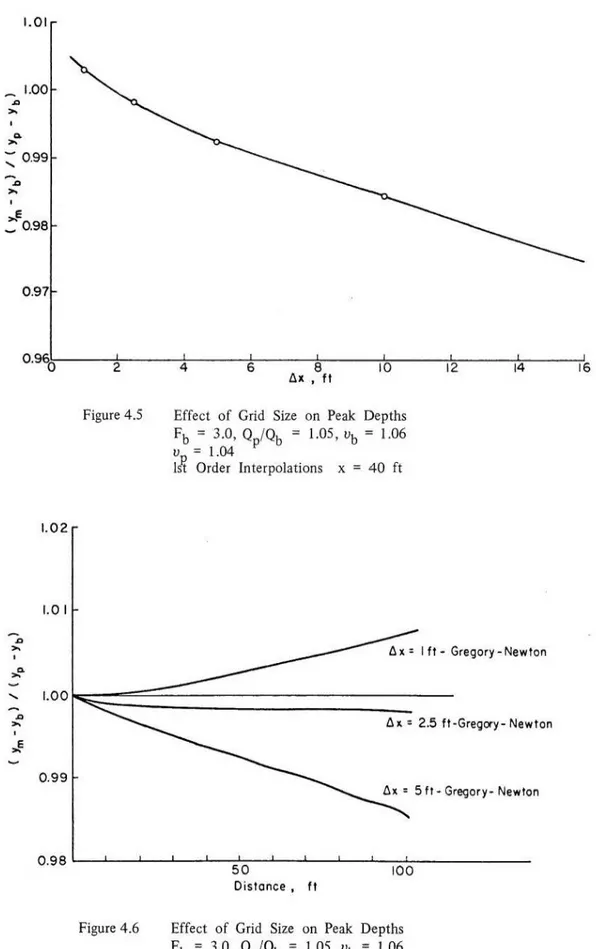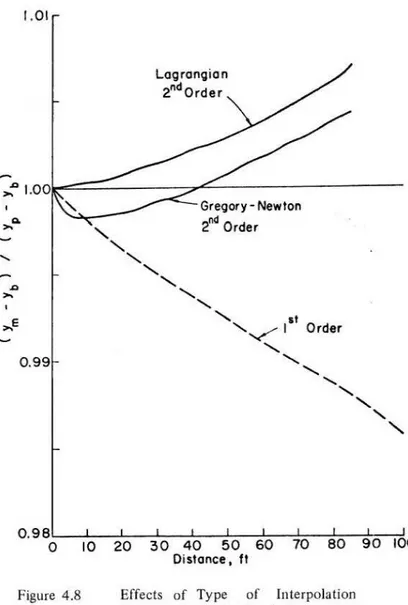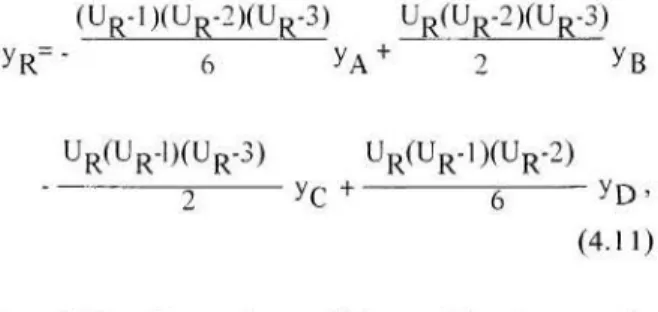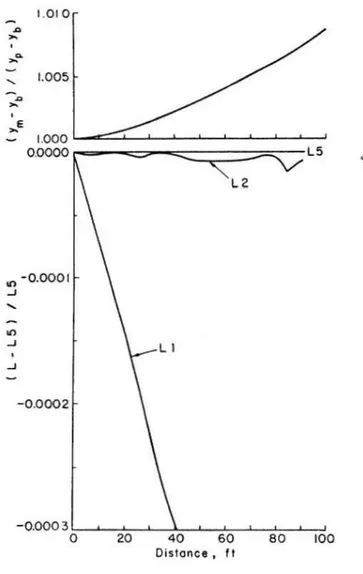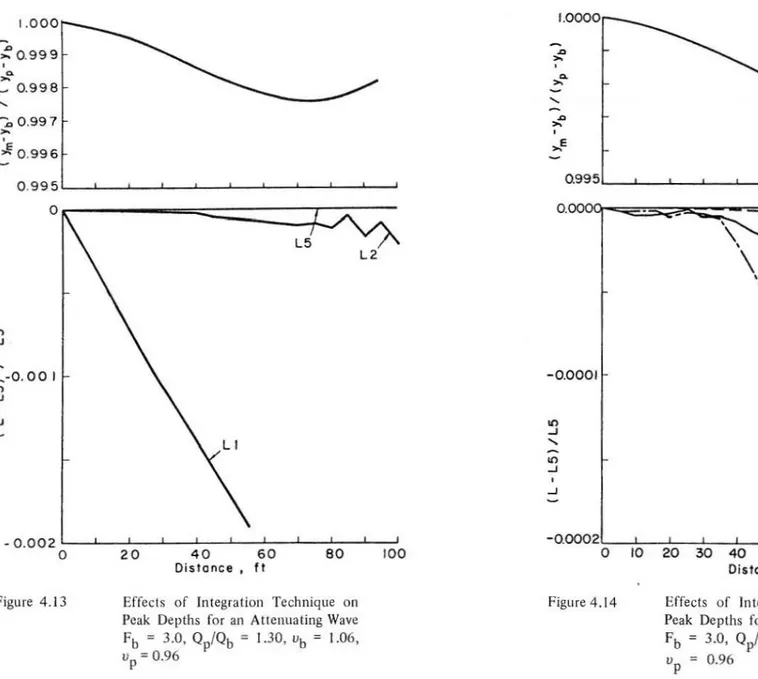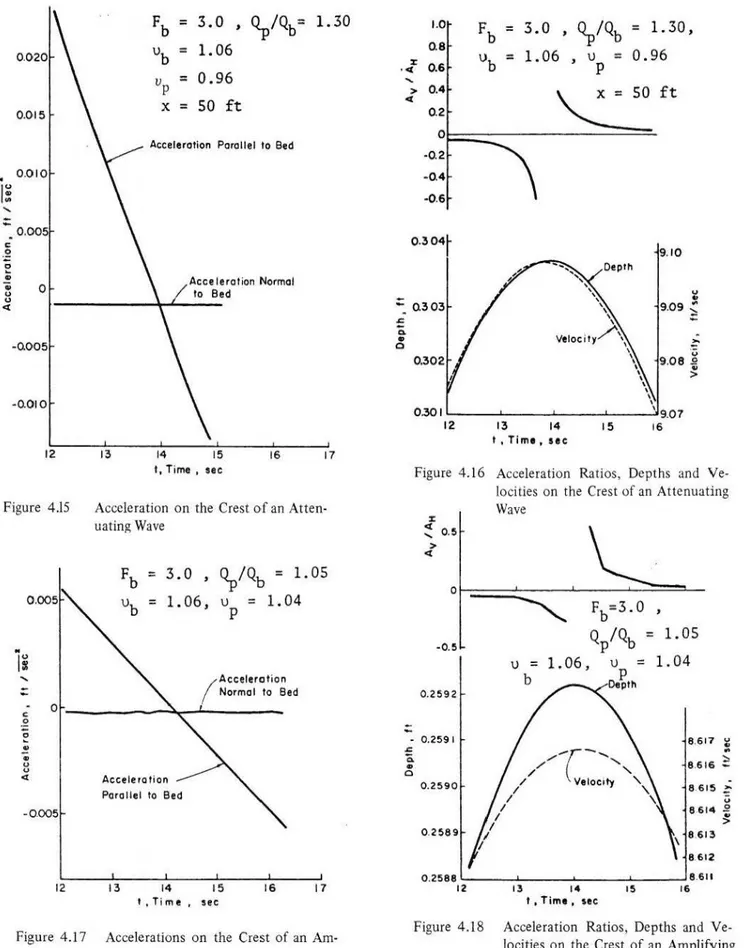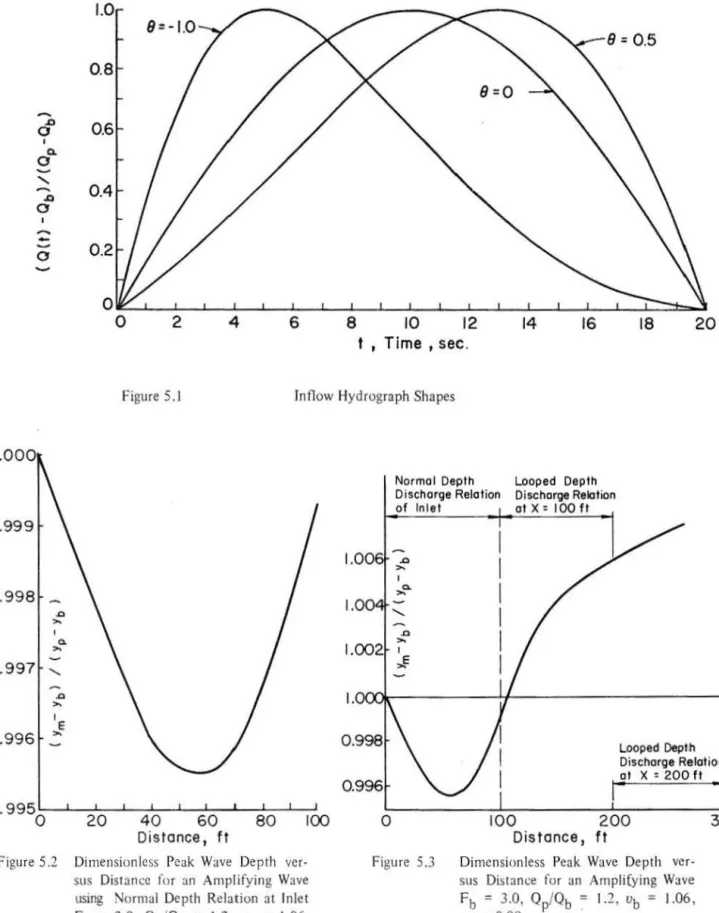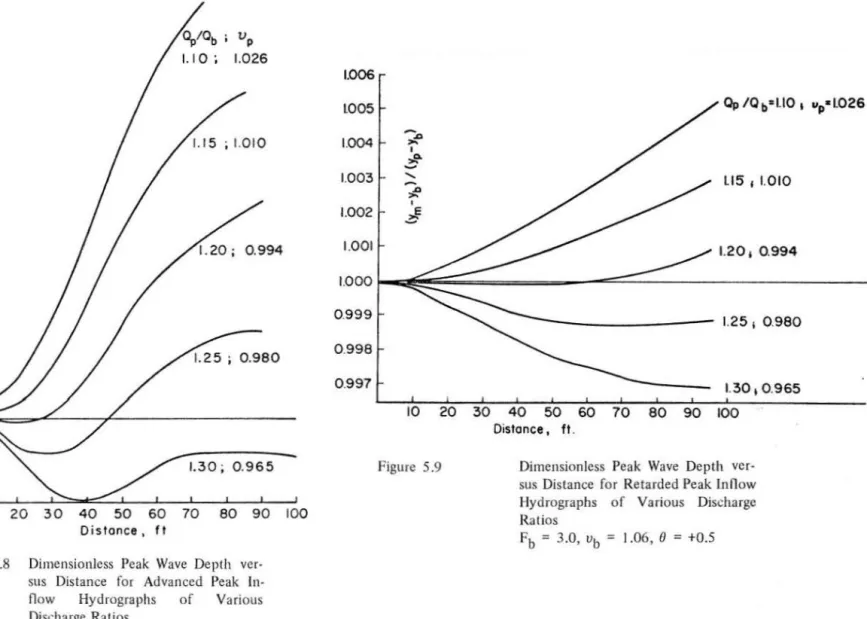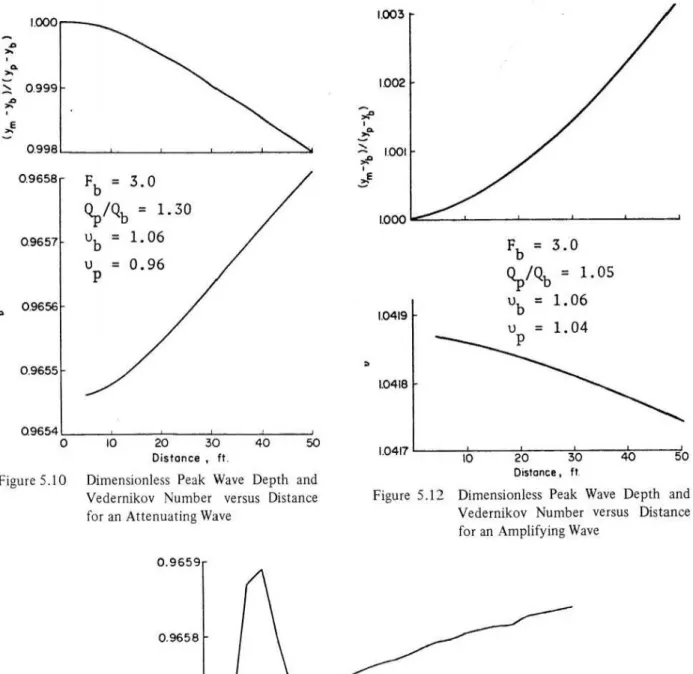AMPLIFICATION CRITERION OF GRADUALLY
VARIED, SINGLE PEAKED WAVES
by
JOHN PETER JOLLY
and VUJICA YEV
JEVICH
December 1971
AMPLIFICATION
CRITERION
OF
GRADUALLY
VARIED
,
SINGLE
PEAKED WAVES
by
Jo
hn
Peter Jolly* and Vujica Yevjevich**
HYDROLOGY PAPERS COLORADO STATE UNIVERSITY FORT COLLINS, COLORADO 80521
• Asslnant Professor. Department of Civil Engineering, Faculty of Science and Engineering, University of Ottawa, Ottawa, Canada. ••Professor of Civil Engineering, Colorado State University, Fort Collins, Colorado.
CHAPTER
2
3 4 5 6 ,·T
ABL
E
OF CON
TEN
T
S
LIST OF FIGURES
LIST OF SYMBOLS
ACKNOWLEDGMENTS, ABSTRACT
INTRODUCTION
LITERATURE REVIEW
THEORETICAL CONSIDERATIONS
3.I
Uniform
Flow
. .
.
. . . .
3.2
Math
ematica
l Development
of
Gradually Varied
Flow Equations
.
.
.
.
. .
.
. .
.
.
.
.
NUMERICAL SOLUTIONS OF GRADUALLY VARIED F
LOW
EQUATIONS
4.I
Intr
o
du
ctio
n
. .
.
.
. .
4.2 Characteristic Grid Scheme
4.3 Specified Int
ervals
Scheme
4.4 Comparisons of Solutions Obtain
ed by
the
Chara
c
teristic Grid
an
d Specified
I
ntervals Schemes
4.
5
Accuracy
of
Specified
I
nterval
s
Scheme in
Simulating Supercritical Flows
4.5 .1
Intr
o
duction
4.5.2 Grid
s
ize
. . .
.
4.5
.3
Integration technique
s
4.5
.4
Flow
acce
leration
co
n
side
ration
s
AMPLIFICATION CRITERION
5.I
Introduction
. . .
. .
5.2
B
ou
nd
ary
Conditions
5
.2.
1 Initial
co
nditions
5.2.2
Inlet
con
diti
o
ns
.
5.3
Flow Simulations
. . .
5.3.1 Choice of
width
-
depth ratio
5.3.2
Amplification criterion
. .
5.4 Some
Characteristics of Supercriti
c
al Gradually
Varied
,
Single P
eaked
Wave
s
CONCL
US
IONS
REFERENCES
PAGE
iv
vii
viii
3
5
5
5 9 9 9 911
121
2
14
1622
2
4
24
2424
2
4
2h
26 2628
37
38
LIST OF FIGURES
4.1
Families of
Characteristic
Curves
for both
Subcritical and Supercritical
Flows
4.2 4.3 4.4 4.5 4.6 4.7 4.8 4.9 4.10 4.11 4.12 4.13 4.14Grid
for
the Solution by Cha
r
acteristic
Grid Scheme
Grid
for
the Solution by Specified
Intervals Scheme
Comparison
of
Solution
by
Characteristic Grid and
Specified
Int
ervals Schemes
.
.
. .
. .
.
.
.
.
.
Effect of Grid Size on
Peak Depths
Fb
= 3.0,
Qp
/
Qb
=
1.05 'Ub
=
1.06 'Up=
1.04 I stOrder
Interpolations
x=40ft
.
. .
. .
.
Effect
of
Grid
Size on Peak D
epths
Fb
=
3.0 'Op/Ob =
1.05 ' Ub=
1.06 'Up=
1.04Effects of
Type
of
I
nterpolation
Equation
on
P
eak
Depths for an
Attenuating Wave
Fb =
1.5 'Op/Ob
=
1.05 'Ub
= 0.53 'Up
= 0.52
Effects of
Type
of
Interpolation
Equation
on Peak
Depths for an Amplifying
Wave
Fb =
3.0 'Op
/
Qb =
1.05 'Ub
= 1.06 'Up=
1.04Effects
of
I
ntegration Technique
on
Peak
Depths
for
an
Attenuating
Wave
Fb
=
1.5 ,Qp/Ob
=
1.05 ,Ub
=
0·.53 'Up=
0.52Effects
of
Integration Technique on Peak
Depths
for an Attenuating
Wa
ve
Fb
=
1.5 ,Op/Ob
=
1.30 ,ub
=
0.53 ,up= 0.48
Effects
o
f
I
ntegration Technjque
on Peak
Depths
for
an Amplifying
Wave
Fb =
3.0 'Op
/
Ob = 1.05
'Ub
=
1.06 ,Up= 1.04
Effects
of Integration Technique
on Peak
Depths
for an
Amplifying Wave
Fb
= 3.0
'Op/Qb
=
LOS ,Ub = 1.06
'Up=
1.04Effects
of I
ntegration
Technique
on
Peak
Depths
for an
Attenuating
W
ave
Fb
= 3.0 'Op/Ob
= 1.30 ,Ub = l.Q6
'Up= 0.96
Effe
c
ts
of Integration Technique on
Peak Depths
for
an
Attenuating
W
ave
Fb
= 3.0
,Qp
/
Qb
=
1.30,Ub =
1.06 ,Ub
=
0.96Page
10 10I
3
13 15IS
17 19 1920
20
21 214.15 4.16 4.17 4.18 5.1 5.2 5.3
5.4
5.5 5.6 5.7 5.8 5.9LIST OF FIGURES (continued)
Acceleration on the Crest of an Attenuating WaveFb = 3.0 ' Qp/Qb = 1.30 ' Vb = 1.06 ' Vb = 0.96 X= 50ft . . . .
Acceleration Ratios, Depths and Velocities on the Crest of an Attenuating Wave
Fb
=
3.0 ' Op/Qb=
1.30' Vb=
1.06 ' Vp = 0.96 X= 50ft . . . .Accelerations on the Crest of an Amplifying Wave fb
=
3.0 ' Op/Ob=
1.05 ' Vb = 1.06 ' Vp = 1.04 Acceleration Ratios, Depths and Velocities on the Crest of an Amplifying WaveFb
=
3.0 ' Op/Qb = 1.05 ' Vb = 1.06 ' Vp = 1.04 Inflow Hydrograph Shapes . . . . Dimensionless Peak Wave Depth versus Distance for an Amplifying Wave using Normal Depth Relation at Inlet Fb = 3.0 ' Op/Qb = 1.2 ' Vb = 1.06 ' Vp=
0.99 1st Order Interpolations . . . . Dimensionless Peak Wave Depth versus Distance for an Amplifying Wavefb = 3.0 , Qp/Qb = 1.2 , Vb = 1.06 , Vp = 0.99 I st Order Interpolations . . . . .
Discharge Ratio at which Vedernikov Number is One versus Width-Depth Ratio
Fb=3.0 . Yb=0.25 , b=O.O , f=O.Ol . . . .
Dimensionless Peak Wave Depth versus Distance for 20-Second Duration Sinusoidal, lnflo'w Hydrographs of Various Discharge Ratios fb = 3.0 , Vb
=
1.06 . . . .Dimensionless Peak Wave Depth versus Distance for 20-Second Duration Sinusoidal, Inflow Hydrographs of Various Discharge Ratios Fb
=
3.0 ' Vb=
1.06 . . . . Dimensionless Peak Wave Depth versus Distance for a ~Second Duration Sinusoidal, Inflow Hydrographs of Various Discharge Ratios Fb = 3.0 ' Vb = 1.06 . . . . Dimensionless Peak Wave Depth versus Distance for Advanced Peak Inflow Hydrographs of Various Discharge Ratiosfb = 3.0 , Vb = 1.06 , 8 = -1.0 . . . . Dimensionless Peak Wave Depth versus Distance for Retarded Peak Inflow Hydrographs of Various Discharge Ratios
fb=3.0,vb=L06,8=+0.5 . . . . Page 23 23 23 23
25
25 2527
27
27
27
29 295.10 5.11 5.12 5.13 5.14 5.15 5.16 5.17 5.18 5.19 5.20 5.21 5.22 5.23 5.24
LIST
OF
FIGURES
(continued
)
Dimensionless Peak Wave Depth and Vedernikov Number versus Distance for an Attenuating WaveFb
=
3.0 , Qp/Qb=
1.30 , Ub=
1.06 , Up = 0.96Vedernikov Number versus Distance for an Attenuating Wave Fb = 3.0 ' Qp/Qb = 1.30 , Ub = 1.06 ' Up= 0.96
Dimensionless Peak Wave Depth and Verdernikov Number versus
Distance for an Amplifying Wave
Fb = 3.0 , Op/Qb = 1.05 , Ub = 1.06 , Up= 1.04 Discharge Ratio versus Froude Number of Base Flow B = 1.2 ft, Yb = 0.25 ft , b = 0.0 , f= 0.01 Dimensionless Peak Wave Depth versus Distance for Various Base Flow Froude Numbers
Qp/Ob = 1.3 . . . .
Dimensionless Wave Depth Hydrographs for an Attenuating Wave
Fb
=
1.5 , Qp/Qb = 1.3 , Ub = 0.53 , Up= 0.48 . . . . Dimensionless Wave Depth Hydrographs for a Mildly Attenuating Wave Fb = 3.0 , Op/Qb = 1.3 , Ub = 1.06 • Up= 0.96 . . . .Dimensionless Wave Depth Hydrographs for an Amplifying Wave
Fb = 4.5 , Qp/Qb = 1.3 , Ub = 1.36 , up= 1.33 . . . .
Dimensionless Wave Depth versus Discharge Plot for an
Attenuating Wave
fb = 1.5 , Qp/Qb = 1.3 , Ub = 0.53 , Up= 0.48 . .
Dimensionless Wave Depth versus Discharge Plot for an Amplifying Wave
Fb = 4.5 , Qp/Qb = 1.3 , Ub = 1.36 ' Up= 1.33 . . Dimensionless Wave Depth versus Discharge Plot for a Mildly Attenuating Wave
Fb = 3.0 , Qp/Qb = 1.30 , Ub = 1.06 , Up= 0.96 Dimensionless Wave Depth versus Discharge Plot for the Crest of a Mildly Attenuating Wave
Fb = 3.0 ' Qp/Qb = I .30 . Ub = 1.06 , Up= 0.96
Velocity Ratio versus Wave Depth for Various Discharge Ratios Fb = 3.0 ' Ub = 1.06 . . . .
Wave Depth where Velocity Ratio is Equal lO One versus Discharge Ratio
Fb = 3.0 . Ub = 1.06 . . . . Dimensionless Wave Depth versus Discharge Plot at the Crest of the Wave for Various Discharge Ratios
Fb = 3.0 , Ub = 1.06 . . . .
Page
30
30 30 31 31 33 33 34 34 34 35 35 3536
36LIST OF SYMBOLS
Symbol Definition Symbol Definition
a Coefficient in frictional law R Hydraulic radius- ft
A Cross-sectional area-fe Re Reynolds number- YR/v
AH Acceleration parallel to channel bed-ft/sec2 Sf Frictional slope Ay Acceleration normal to channel bed-ft/sec2 So Bed slope b Exponential coefficient in frictional law Time- sec
B Base width-ft v Velocity of water particle -ft/sec
c
Chezy resistance constantv
Average velocity - ft/sec Cs Frictional law constant Vf Velocity on wave front- ft/secc6
Frictional law constant Yo Uniform flow velocity -ft/sec d Cross-sectional shape factor Yr Velocity on wave rear- ft/secf Frictional factor X Distance - ft
F Froudc number- Y/.jfy y Depth - ft
Fb Froude number of base flow Yb Base depth -· ft
Fp Froude number of wave peak Yo Uniform flow depth- ft
Fs Stability Froude number {; + Slope of positive characteristic
g Accelerations due to gravity - 32.2 ft/sec2 € Slope of negative characteristic
k Roughness height A Peak parameter of inflow hydrograph
K
f/8g8
Skewness parameter of inflow hydrographL Reference for integration technique I) Kinematic viscosity m Subscript representing maximum depth at any x p Mass density
p Wetted perimeter- ft
u
Vedernikov numberq Lateral discharge - ft3 /scc/ft Ub Ycdernikov number of base flow Q Discharge - fe /sec Up Vedcrnikov number at wave peak
ACKNOWLEDGMENT
This paper is based on the Ph.D. dissertation submitted and defended by J.P. Jolly, and guided and advised by Dr. V. Yevjevich, the major professor and chairman of the Ph.D. committee. Acknowledgment goes also to Dr.
Albert H. Barnes, Associate Professor of Civil Engineering at Colorado State University, for his advice and cooperation, as well as to other members of the Ph.D. committee.
Acknowledgments also go to the U.S. Federal Highway Administration, previously the U.S. Bureau of Public Roads, for their support of the project "Unsteady Free Surface Flow in a Storm Drain," from which some materials have been used, and to the Computer Centre of the University of Ottawa, Ottawa, Canada, where the simulations were made.
The Department of Civil Engineering of the University of Ottawa, Ottawa, Canada, and the Department of
Civil Engineering of Colorado State University, Fort Collins, Colorado, U.S.A., have given all necessary help and encouragement for completion of this study. Both writers gratefully appreciate the support of these institutions.
ABSTRACT
Some hydraulic properties, obtained using the Chezy resistance law, that distinguish amplifying waves from attenuating waves are found by a numerical integration of the governing hyperbolic, partial differential equations of supercritical, gradually varied waves flowing in a channel with a rectangular cross section. The supercritical, gradually varied flow is simulated by using various integration techniques of the specified intervals scheme of the method of characteristics solution to the governing system of equations. One of these integration techniques is
used to determine attenuation and amplification characteristics of gradually varied, single peaked waves. Prior to this determination, criteria found by various investigators for predicting the stability of uniform flow are shown to be equivalent. One of the criteria, the Vedernikov number, which contains parameters dependent on the
frictional law, channel cross-sectional shape and Froude number, is also the criterion for predicting amplification of gradually varied, single peaked waves.
Chapter
1
INTROD
UCT
ION
In most natural and artificially constructedstreams, once a flood wave is in.itiated it will attenuate as it travels along a channel. In some
streams or along spillways, and in many storm
culverts, however, the flow may become supercritical;
and if the Froude number (F : V
f
.JiY)
is above a.certain value, the peak depth will increase with
distance along the channel. These increases in flow depth can cause excessive hydrodynamic pressures to come to bear against hydraulic structures, as in the
case of a tailrace structure of a hydroelectric station
in the USSR as related by Ghambarian (1965); or
cause the flow to overtop the banks of channels with
steep bed slopes, as is the case of an irrigation canal in
Los Angleles - Brock ( 1967). A criterion or criteria
have not, as yet, been developed to determine
whether or not these supercritical waves will grow in height along a channel.
Instability in open channel flow is defrned as
flow conditions that result when the peak depth of
flow or peak value of any other parameter increases with distance along the channel. In steady flow, the water surface profiJe develops into a series of roll waves that increase in depth at the crests and decrease in depth at the troughs as it travels down the channel.
This is normally referred to as roll waves, and
represents instability of steady flow. With unsteady,
smgle peaked waves instability occurs when the peak
depth of the wave increases with the distance along the channel. This instability has been often observed in nature in open channels (Blair, Cornish, and
Holmes) and normally is referred to as the passage of
gradually varied waves to slug flow.
Unsteady flow may either be gradually varied
or rapidly varied. The equations governing the gradually varied flow are one-dimensional. For this flow it is assumed that the vertical accelerations are small compared with the total accelerations. With
rapidly varied flow the governing equations are
two-dimensional, and the vertical accelerations along
the channel are large when compared with the accelerations parallel to the channel bed.
During the past century, numerous engineers
and mathematicians have developed criteria for deter-mining the stability of open channel flow for a uniform regime but not for unsteady flow. In general,
these criteria give the Froude number above which
3y
3y
(
-
=
0 , -=
0 ) becomes unstable3x
3t
uniform flow
for a particular geometry of the cross-sectional area
and the resistance law of flow. These efforts have
been culminated with the work of Vedernikov lwasa Craya, Keulegan and Patterson, each
d
eve
l
o~ing th~
same criterion, but by different methods.
Until 1960 all experiments in open channel flow hydraulics were conducted either in the labora-tory under controlled conditions or in the field. The
types of flow observed were classified as steady or
unsteady and either uniform, gradually varied, or
rapidly varied. Mathematical equations have been
derived to describe these various types of flow - see
bibliography on unsteady flow by Yevjevich (1964).
The solution of these equ,ations represents the flow
that would occur in a physical state_ The available
solutions of these equations, however, were limited to
simplified conditions such as the bed slope and
frictional resistance being equal to zero. Fortunately
during the 1960's methods and techniques became
available for simulating gradually varied flow by the mlmerical integration of the governing equations on a digital computer, thereby providing an alternate to the physical experiments.
In both cases, physical and numerical experiments, there are always errors. In a physical
experiment there are errors resulting from the speci-fication tolerances of the boundary and the initial
conditions and in the means of measuring the flow
parameters. In a numerical experiment, or simulation, although the boundary and initial conditions can be·
prescribed with precision, there still remains both truncation errors in the computations, errors in the
written output, as well as errors resulting from the fmite difference approximations to the mathematical
derivatives and in the integration of the partial
differential equations.
Using the work by Yevjevich and Barnes (1970) and Zovne (1970) on the numerical solution as a point of departure, it .is the objective of this paper to determine the criterion or criteria for instability of gradually varied, single peaked waves. These criteria are determined by numerical simulations, which are
assumed
to be
sufficienlly accurate and far
less
expensi
v
e
to arrive at than from
phy
s
ical
expe
rim
ents.
Moreover
,
it is
questionable
whether
measuring techniques are yet available to accurately
det
erm
in
e,
both
spatially
and
temporally,
the
de
pths
and velocities
s
imultaneously
of
flows
with
high
F
r
oude
numbers.
T
o
descr
ibe these
stabi
lity
phe-nomena
certain
terms have been
used
in the
past.
ln
the work
on
uniform flow
regimes,
the development
of roll waves
has been
referred to as
free
surface
instability (Koloseus and
Davidson)
or
as
instability
(
l
wasa). The
only anal
ytica
l
work so far on the
same
typ
e
of
problem in
supercritical, gradually
varied flow
(Zovnc)
also
uses the terms
stabili
ty and instability.
Both Zovne
and
the writers have used the numerical
sol
utiorr
on
.
the
graduall
y varied flow
equations
in
s
tudying waves
in supercriticaJ regime.
The
solution
of these equations can
be
numerically
unstable under
certai
n
co
nditions
when the flow
is
stable.
Therefore
,
the writers will not use
the
term stability
as use
d
in
the hydraulic
sense
when
discussing gradually varied
flow.
Rather
,
when the peak depths of gradually
varied,
single
peaked waves become smaller as the
waves travel
along
a
channel,
they are said to be
attenuating;
when
the peak depths become
larger
as
the waves travel
along a channel,
they are said to be
amplifying.
When
discussing other
works
with
uniform flow,
h
owever,
the term
stability
will be
used. Therefore, what is being considered
is
the
criterion or cri
teria
for
amp
lifi
cation
of a wave
travelling along a channel
whose
slope
is
supercritical
with
respect to the base f1ow discharge of the
hydrograph.
I
n
other
words, the
amplification of
a
single peaked, supercritical
wave, w
h
ich is
governed
by
the equations of gradually
varied flow, is
studied
with re
spect
to
finding criterion or criter
ia
for
amplification.
Chapter 2
LITERATUR
E
REVIEW
There have been at least three occasions when amplifying waves have been observed in nature and recorded in the literature. Cornish ( 1934) was the fust to mention that the peak depth of supercritical flow in open channels could amplify. By observing the flow in drainage channels in the Swiss Alpes, he noticed that a series of roll waves formed which grew in height as they travelled along a channel.
Two years later Holmes (1936), standing on a bridge over one of the flood control channels in Los Angeles, observed over an interval of several minutes that the flow depth increased from approximately three feet to approximately eight feet and then subsided to three feet. This was followed by another wave of larger amplitude which also subsided to the original flow depth.
Bl~ir
(1961) reported.that on the Nisqually River in the State of Washington in October 1955 that two National Park Rangers observed five or six surges over a duration of 45 minutes which were 15 to 20 feet higher than the water level immediately in front of the surges. The flrst surge washed away a highway bridge that had had 40 feet clearance abovethe alluvial bed.
There has been no detailed experimental or theoretical work published that explains why the flow conditions cited above do occur in nature. Moreover, all analytical and experimental studies of amplification in the supercritical regime have been limited to supercritical, uniform flow with the exception of Zovne's work with supercritical, non-uniform flow which will be discussed later.
A review of some of the analytical work on stability criteria for uniform flow is as follows.
Keulegan and Patterson (1940) determined a stability criterion mathematically from Boussinesq's equation for the velocity of propagation of a volume element of a wave and an equation relating frictional resistance with depth for supercritical, uniform flow. They determined that instability will occur when the gravitational force is greater than the frictional force. Their stability criterion is
2 fpV pgyS -o
8
funs table} lstableJ
>
<
0, (2.1)or in terms of slopes in dividing Equation 2.1 by pgy it can be expressed as
[unstable]
>
0
so -
sf
stable '<
(2.2)
In Equations 2.1 and
2.2,
p is the fluid density, g isthe acceleration due to gravity, y is the flow depth, S0 is the bed slope, f is the frictional factor, V is the flow velocity' and Sf is the frictional slope.
Also, Vedernikov (1945) determined a stability criterion by using the equations of gradually varied flow and by considering the time growth or decay of energy of a small disturbance on a steady, uniform flow. His criterion is
1 - b dP
u = ( - - ) ( 1 - R - ) F
2
+
b dA(2.3)
in which
u
is the Vedernikov number, b is the exponential coefficient in the resistance law f= a(Re)b for a hydraulically smooth conduit, R is the hydraulic radius, P is the wetted perimeter, A is the cross-sectional area, F is the Froude number and a is a coefficient. Whenu
>
I the flow is unstable; when u=l the flow is neutrally stable; and whenu
<
1 the flow is stable.Craya (1952) considered steady flow near normal depth thereby eliminating the terms in the gradually varied flow equations that vary with time; thus the partial derivatives become total derivatives. He showed that the flow would become unstable when the Seddon* celerity, dQ/dA , is greater than the Lagrangian celerity, V +
.J'iit ,
i.e.,dQ/dA
>
V+
.JiY
(2.4}Iwasa (1954)' considered the initiation of continuous time growth of an infinitesimally disturbed wave. His criterion for flow with uniform velocity distribution is as follows.
*This celerity is known in the literature under the name Seddon, or Kleitz-Seddon, though the first author to obtain it was Graeff (187 5) before Kleitz (1877) and Seddon ( 1900).
R
dA V>
dy - ..L-= Fs< -
-
-
- -
- - - -
-
-(gA
AdR 3~
j
dA/dy -d-yc
2
x 0.4343c
5
f+
o.s)
(2.
5
)
in which f is given as 1 f = - -- - -4R 2[C5
log(T
c
6)]k is the height of the resistance roughness, C5 and
c6
are constants.Iwasa's criterion reduces to Vederni.kov's for compatible conditions.
Koloseus and Davidson (1966), with uniform flows developed in a 3.0 foot wide and 85 foot long flume, obtained good correlation between the sta -bility criterion of Keulegan and Patterson and the development of roll waves. They defjned "roll waves" as any wave of spontaneous origin, regardless of size or shape, that is attributable to no cause other than the superiority of the gravitational force over the boundary retarding force. Although the work by Koloseus and Davidson is interesting but limHed to
depths near normal depth, it is shown in the next chapter that the criteria of Vedernikov, Keulegan and Patterson, and Craya, although expressed in different terms, are equivalent.
One investigator who did not limit his work to super critical, uruform flow was Zovne (
1
970
)
.
Using a digital computer he compared simulated, gradually varied flows. in the supercritical regime with two numerical schemes. He simulated the flows with both the characteristic grid scheme and specified intervals scheme of the method of characteristics and showed that each method gives almost identical results. Both the characteristic grid and specified interval schemes are ways in which the equations of gradually varied flow may be solved by the method of characteristics. He also simu.lated with the specified intervals scheme an experiment in a flume where the raising of a tailgate caused a hydraulic jump to move upstream. In his simulations a sequential depth relation was u'sed, and the wave profiles were not determined at the jump. The experimentally determined and numerically simulated positions of the physical jumps wer.e compared as they moved upstream. Zovne's work provides proof that supercritical, gradually varied flow can be simulated with the method of characteristics. Some of his results are djscussed in Chapter 4.,·
Chapter
3
THEORETICAL CONSIDERATIONS
3.1
Uniform Flow
In the previous chapter it was stated that the stability criteria developed by Keulegan and
Patter-son, and then by Vedernikov and later bv Crava
are one and the same. To understand this, the work by Keulegan and Patterson should be considered in terms of gravitational and frictional slopes, i.e., instability will occur when S
0
>
Sf
Craya states,moreover, that instability will occur when the Seddon celerity is greater than the Lagrangian celerity. The Seddon celerity represents the speed of travel of a small wave that has stabilized at an invariant form
and is governed by channel resistance_ The Lagrangian celerity represents the speed of travel of a very small wave under the exclusive actions of inertia and gravity. Since the Seddon celerity is inversely related
to the frictional slope, one may state
that dQ/dA
>
V +.J"iY
is equivalent>
<
to
so
<
sf
Consider again the celerity relation for instability dQ/dA
>
V+
ygy , in a prismatic channel such that y=
A/B , and A/PR=
I,I-b
[ - ]
f
bV = KR 2
+
b in which K =8g
and f=a(Re). The Seddon celerity dQ/dA may be expressed asdV V+A
-dA '
(
3.
1)
and by differentiating the expression for velocity with respect to area
I+ 2b
dV =K(l-b) R 2+b dR
dA (2 +b) dA (3.2)
Now dR/dA may be expressed as
d(A/P) I = -dA P A dP I dP P2 dA =
P
(1 • R dA ) . (3 .3) Therefore dQ I-b A dP - = V + V(- ) - ( 1 - R - ) M ~b PR M (3.4) Equation 3.4 becomes dQ 1 · b dP - =V+V(- )(l·R - ) .(3.5)
dA 2 + b dAThe criterion for unstable conditions may be expressed by
I· b
dP V(- ) ( I -R - ) 2+ b dA orv
>
- - - . (3.6)I
-
b
dP (- ) (I·R - ) 2 + b dAThe left side of Equation 3.6 is by defmition the Froude number, F ; therefore, the criterion may be rewritten in the form
F
=
(3.7)1 - b dP
(- ) (l·R - )
2+b dA
The Verdernikov number is defined by Equation 2.3, or
1 -b dP
v
= ( - ) ( l · R - ) F 2+
b dAwhich is identical to Equation 3.7, thus the criteria of
slopes - Equation 2.2, Verdernikov number -Equation 2.3, and celerities - Equation 2.4,are one and the same.
3.2
Mathematical Developm
en
t
of
Gradually
Varied Flow Equations
The equations of gradually varied flow, known as the Barre' de Saint-Venant equations, are equa· tions of conservation of mass and conservation of linear momentum or
dV dA dA
A -
+
V -+
-
•
q = 0 , (3.8)dx dx dt
dV
dV
dy
pVq
a
v
-
+
~-+
g -=
g(S
0-Sf)
-A""
,
(3.9)
dx
dt
dx
as
the
conservation of
linear momentum, in
which
I a= - -
I
I
v
3dA
AV
3A
(3.10)
and
1 ~=-II
v2dA
AV2 A(3.1
I)1
n
the
latter two
equations
v
is the
velocity at a
point
in
the
cross
section.
T
hese velocity
coeffic
i
ents,
Equations
3.10 and
3.11,
depend
on
the
velocity
dis
t
ri
bu
tion in a
cross
sec
tional
area of
flow.
l
t is assumed in this
study
that
the velocity distribution is
uni
f
orm; therefore,
a=~ I .Neither the
lateral inflow nor
outflow
di
scharge,
q
,
are
conside
red
in this
st
udy
.
Be
cause
of the assumed
uniform
veloci
t
y
distribution and
because
lateral inflow
or
outflow are
not
cons
id
ered,
the above equations
sim
plify to
and
dV
dA dA A -+
V -+
-
== 0(3.12)
dx
dx
dt
V
dV
IdV
-
- +
gdx
gdt
dy
+
- =s . sf
dx
0 (3.13)
In using
Equations 3.12 and
3.13
to
model
physical flow, the following assumptions are made.
(
1
)
Vertical accelerations a
r
e negligible
.
(2)
The
channel
bed
slope is
mil
d
eno
u
gh
so
that
tana
=s
ina
.
(3)
Th
e
frictional
slope,
Sf,
ca
n
be
represented by the
Darcy-Wei
s
ba
ch
re
l
a-ti
on
hf=
f
LV
2/
2gd
R
in which f is
the
friction factor
as
a
function
of
R
eynolds
number
of
the flow an
d
it is assumed to
be
the same value for
unsteady flow as
for steady
flow, and d is a shape factor.
(
4)
The pressure throughout the flow
d
omai
n
is
hydrostatic.
The third assumption is su fficiem but not
necessary.
Any mathematical
relationship for
fric-tional
slope or any relation
that
equates
it to
a
constant
value will
suffice.
Mor
eo
ver, in this
s
tudy
,.
t
he
Chezy resistance
law
is
used. The
fo
ll
owing shows
the
relationship between
the Chezy
and
Da
r
cy-Weisba
c
h
relati
ons.
The Chezy
resistance Jaw
relates
fl
ow velocity
to hydraulic radius and the f
r
ictional slo
p
e.
I
t
may
be
stated
as
V
=
C
vRSf
in which
C
is
the Chezy
constant.
The Dar
cy-
Wei
s
bach
resistance states
that
Sf=
f
V
2/2gd
R in
which d is a constant
that
is
dependent
onlyon
the
cross-sectio
n
al
shape
.
For
circ
ular
sections
d is
equal
to
four,
and
for
very wide
rectangular
cross sections
d is equa
l
to one.
Ot
her
cross-sectiona
l
shapes
have intermediate values
of
d .The
frictional factor,
f, is relate
d
to
R
eyno
l
ds
number
by
f =a(Re)b
in whkh Re
= Vyfv ,in
which
v is kinematic viscosi
t
y. Thus, the
Darcy-W
eisbach relation may be
written as
a y2
+
bs f =
-2g
dvbRl-b
and the
Ch~zyrelation as
The
two relations
are the same when
b
=0
and
C
=J2gdv/a ,
which is a
constan
t f
or
given
con
di
-tions
o
f
fluid, temperature, cross-sectional shape and
r
o
ughne
ss.
The
eq
u
ations
of
unsteady
free-surface
flow,
Equations
3.
1
2
and
3.13
,
form a system of
quasi-linear, partial hyperbo
l
ic differen
t
ia
l
eq
u
ations of the
first order.
Vari
o
u
s
possib
l
e
methods
for integrating
these
two
partia
l
diffe
r
entia
l
e
q
ua
t
ions
ar
e revie
w
ed
in ref
e
rence
s
abstracted by Yevjev
.
ich
(1964). One
of
th
ese
methods is the method of cha
r
acter
i
stics which
was
s
hown
by Zovne
(
1
970)
to be applicable
for
s
upercriti
ca
l
flow.
J
t was developed by
M
assau (1889)
f
o
r integrating th
e
two
partial
differentia
l
equations
of
un
s
t
eady
fl
o
w in
channe
l
s
by
a graphical
pr
ocedu
r
e·.
T
h
is
method
ha
s
been
a
l
so
widely used f
o
r
the
so
luti
on of a
variety
of
p
roblems
in phy
sics an
d
mechani
cs,
and
its
detaile
d
description
can
be
found
in Courant and Freidrichs (I
948
)
,
Crandall
(19
56
)
,
and Streeter a
n
d W
ylie
( 196
7).
Th
e solut
i
on of
a
specific
problem by
the
method
of cha
ra
cteris
ti
cs
using hand calculation,
o
r
graphica
l
means,
o
r
desk
calc
ulat
o
r
s
is
extreme
ly
laborious and time
consum
in
g.
A
s
a result in the
interval
between
1
889
and
the
advent of electronic
co
mputer
s,
a variety
of sc
h
e
me
s
for solving open
c
hann
e
l
flow problems by this
method was
proposed. The details of these various schemes can be found in references abstracted by Yevjevich
(1964).
In general, solutions by the method of characteristics may be performed in two ways:· by the graphical
method and by the use of digital computers. Of the
two, digital computer provides several advantages. A digital computer can not only do the tedious com
-putations that are required for the graphical method, but it can also give the solution for the complete system of equations to a better degree of accuracy
and precision.
In both procedures the method of
characteris-tics uses the equations of continuity and momentum of unsteady t1ow,
(3.12)
and(3.1
3
)
,
along with the total differentials of the dependent variables, velocity and depth, which constitute four characteristicequations. By considering only prismatic channels
-those of unvarying cross-sectional areas and constant
bed slopes - then the cross-sectional area may be described by A = By where y is the hydraulic depth. Thus, the characteristic equations are
and A av ay 1 ay
- -
+
-
+
- -= VB ax ax V atv
av- -
+
g
ax av- +
g
at av dV=rx dx+dt ay dt, ay ay dy = - · dx + - dt ax at0
,
(3.14)
(3.16)
(3
.
17)
The partial derivatives of y and V with respect to x and t are unknown, therefore, there are four equations and four unknowns. A method is now described that shows how the four equations are solved simultaneously for V and y at any x and t . The four equations can be expressed in the matrix equation: A 1 av
VJJ
0v
Ox
0v
I av 0Ot
=
So-sf g g ay (3.18) dx dt 0 0Ox
dV 0 0 dx dtOt
ay dyThis equation may be expressed in the format of matrix algebra as: [M] x [Z] = [N) , in which
[M] is the coefficient matrix, and [Z] and [N]
are vectors representing the unknown partial derivatives and the right side of the equation,
respectively.
To obtain a solution of V and y at any x
and t from this equation, let t.M be the determinant of a matrix [M) and
let AK.i represent a matrix formed by replacing a
column (i) in [M) by [N) . From matrix algebra it
may be proved that Zi
=
.6K/ t.M . The rows of [M] are linearly dependent, i.e., there is an interdependency between the values of y and thevalues of V at any x and t.To satisfy this
interdependency the determinant of the coefficient
rna trix t.M must be equal to zero. Here the
equation [M] [Z] =
[N
]
becomes indeterminateav av ay ay and the values of - - - and - are
ax 'at . ax at not uniquely determined, i.e., zi
=
AK/t.M =0
/
0.
Therefore, since the derivative must be finite in the flow phenomenon considered, t.Ki must equal zerowhenever .6M equals zero.
By expanding the determinant of [M) and equating it to zero, a quadratic equation in dt/dx is
obtained. Solving for both positive and negative
values of dt/dx the following is obtained
dt
<crx}
=
- -
-
--v+VAiJB(3.19)
and dt(QX")
-
,
= V- JAg/B e_ •(3
.20
)
The curves in the distance-time plane on which .6M = 0 are called the characteristics curves. On each, the value of dt/dx is a constant.
By expanding the determinant of any of the
four t.Ki in Equation 3.18 and setting it equal to
zero, four different but equivalent partial differential
equations are obtained of the type shown in the following equation.
{ A V d t I } dy A dV
[
- -
-
]
-
+
-
-
+ --
+
VB g dx g dx VBg dx A dtW
(So· Sf)-co.
dx (3.21)SubstJtuting the values of e±from Equation 3.19 and 3.20 to· Equation 3.21 the following ordinary differential equations in V and y are obtained:
{ A V
1J
dy A dV[ - -
-
]e
.+
- -
+
- -
+
VB g g dx V Bg dx (3.22)[
[
~-~]e.~}
dy+~
dV+
~
VBg
g
dxVBg
dx A"VB
(S0 . Sf) e_=
o,
(3.23)
along the positive and negative characteristics, respectively.To numerically integrate the above equations in order to determine the depth, y , and velocity, V , at any distance, x , and time, t , in a channel there are many schemes. Two of them are described in the next chapter. To reiterate both are schemes of a class of solution known as the method of characteristics. One is called the characteristic grid scheme; the other
,.
C
h
a
pter
4
N
UM
E
RI
CAL S
OL
UTI
O
NS O
F
G
R
A
DUALL
Y
VARI
E
D FL
O
W
EQUAT
IONS
4
.1 Intr
o
du
ct
ion
In part 3~2 of Chapter
3,
in which themathematical equations of gradually varied flow were
discussed in terms of the characteristic equations,
both the characteristic grid and the specified intervals
schemes of integrating the equations were mentioned.
There are many other methods available by which
these equations can be integrated, such as the
Lax-Wendoff and the diffusing schemes. A survey of
the available methods with a discussion of their
advantages and limitations for the numerical integra·
tions of the gradually varied flow equations may be
found in a recent publication by Yevjevich and
Barnes (
1970).
These investigators recommended theuse of the method of characteristic over any other
method. The two schemes of the method of
characteristics are described in the following
para-graphs.
4
.
2 Characte
risiti
c G
rid
Sc
h
e
m
e
The pair of first-order equations that represent
the flow, Equations
3.22
and3
.23,
of the previouschapter, have two real roots,
(OX).=
dt E+ anddt
<ax)
_
=
e_. A curve that at each of its points has dtthe slope
<ax)+
is called a positive characteristic. A curve that at each of its points it.tS the slopedt
(CIX)_
is :ailed a negative characteristic. Thereare, therefore, two families of intersecting curves that
fill out the domain of the independent variables x
and t . Typical patterns of intersecting characteris·
tics for subcritical and supercritical flows are shown
in Figure 4.1.
By a simultaneous solution of Equations 3.19,
3.20, 3.22,
and3.23,
the depths and velocities of the flow may be determined at the points where thepositive and negative characteristics intersect. They
are found by integrating from two grid points where
y and V are known, points R and S , to the third
point, P which is the intersection of the characteris
-tics that pass through points R and S shown
schematically in Figure 4.2. To obtain y and V at
point P after knowing their values at points R and
S the equations resulting from the simultaneous
solutions of Equations
3.19,
3.20,
3.22
and3.23
are solved in a sequential order. These equations are:xs-xR + tR(VR+
v'iY'R).
ts(V s. -hYs>
tp= (4.1)
(4.2)
(4.3)
By means of the above equations y and V
can be determined at any point on the (x,t)-plane by
changing the grid size or shape by varying .:lt and .:lx.
4.3 S
pe
ci
fi
e
d In
terv
als
Sc
h
e
m
e
One way to describe the specified intervals
scheme for integrating the equations of gradually
varied flow is to consider the (x, t)- plane subdivided
into grids of equal sized rectangles, each .:lx long
and .:lt high. The initial conditions V and y arc
known along the lower boundary corresponding to
t = 0 and the upstream conditions are known along
the left boundary of Figure 4.3.
Assuming that y and V are known at every
grid point along the line t = 11 • tlt as shown in
Figure 4.3, then y and V can be determined at the
grid points along t
=
t1 in the following manner.Consider that y and V are to be determined at
point P . By determining the slopes of the
charac-teristics that pass through point P , the positions
where the characteristics cross the line t1 -.:lt (points
R and S) can be found. The values of depths and
velocities at these points can then be calculated by
(a) Subcriticol Flow F < I
£t=--==-Vt../9Y
IE =
-V-../QY
(b) Supercriticol Flow I€-
•
-F
>I
Fi
g
ure
4.1
b
Fi
gure
4.2
V-ffy"
Families
of
Characteristic Curves
for
both Subcritical
and
Supercrit
i
ca
1
Flows
Grid
for the Solution
by
Chara
cte
r-istic
Grid
Scheme
X
neighbourhood of points R and S . From these values the frictional slopes and the coefficients in Equations 3.22 and 3.23 can be evaluated, and the
equations can be integrated along the characteristics
to determine y and V at point P .
Equations 3.22 and 3.23 may be expressed in the following algebraic form proceeding from points
R and S on the t1 -At )jne to the point P on the t1 line, as
(FJR(Yp·YR) + (GJR(VP-VR)
+
(SJR (xp-xR) = 0 , (4.5) along the positive characteristic, and as(FJs(Yp·Ys)
+
(GJs(Vp-V s)+
(SJs(Xp·xs) = 0,(4.6) along the negative characteristic. In these equations the coefficients have
{,A
V
I
}
(FJs =l
[vs
.
g-
1
e_+g-
s , A (GJR=
(VBg )R ' A (GJs =Cvsg
)
s
,
andUsing the values of V and y at points R and
S , Equations 4.5 and 4.6 are solved simultaneously to determine the depth and velocity at the point
P, i.
e., [(T.)R (G.)R] (TJs (G)s (4.7)Dp
=
[
(F j R (G.)R] (FJs (G_)s and [ (F.)R(
T
.)
Rl
(F Js CTJsv
---p -[(F.)R (G.)R] (F Js (GJs (4.8) in which (TJ R = (F.)R · YR+
(G.)R VR · (S.)R (xp-xR), and (T Js = (F Js Ys + (GJs V S. (SJs(Xp·Xs) .The solution is continued in the x direction ftrst and then continued for successive values of t , at At intervals apart, until the flow in the channel is
simulated for a specified duration.
4.4 Co
mp
ariso
n
s
of So
lu
t
i
ons
Ob
ta
in
e
d
b
y
th
e
Charact
er
i
s
tic Grid and
Specifie
d
Interv
al
s
Sc
h
e
m
es
Some of the disadvantages in using the
cha.racteristjc grid scheme are as follows.
1. The depths and velocities are obtained on the (x,t)-pJane in an uneven distribution of grid points. To obtain results in an orderly distribution, interpolations for calculated depths and velocities must be carried out in the x and t directions. Any
order of interpolation possesses certain numerical errors that undermine some of the precision of the
characterisitc grid scheme.
2. It is difficult to space the characteristics of the same sign a suitable distance apart along the x and t axes. For example, the flow regimes in regions I and 3 in Figure 4.1 are independent of each other, and the flows in region 2 are dependent on conditions
in region 1 and 3; therefore, it is impossible to know the spatial intervals of the characteristics in region 2
beforehand.
3. Members of the same family of character
is-tics in the supercritical regi.me may converge with flows of high Froude number. When this occurs, the depth and velocity at the grid point are no longer
In contrast to the problem associated with the
characteristic grid scheme, the specified intervals
scheme has certain advantages. One of them is that
the grid spacing is known beforehand. The numerical
solution is also more systematic, and the depths and
velocities can be obtained at grid points where
adjacent characteristics converge, which is precluded
in the characteristic grid scheme.
Some of the work by Zovne can be used to
infer other advantages in using the specified intervals
scheme. He considered hypotheticaJ, supercritical
flow in which a linearly decreasing hydrograph was
simulated by both the characteristic grid and the
specified intervals schemes. His results are shown in Figure 4.4. It can be seen that the solutions from the
two schemes are almost identical which, in view of
the difficulties of the characteristic grid scheme
described above, lends support to the use of specified
intervals scheme for simulating supercritical flows in
this and similar studies.
Some of the assumptions necessary for using
the specified intervals scheme are as follows.
I. Interpolation must be used to determine the
depths and velocities at the points where the charac·
teristics that pass through point P cross the line
t J ·bot, (points R and S).
2. It is assumed that the slopes of the charac·
teristics at point P are the same as at point C . In
other words, it is assumed the change in slopes of the
characteristics over a bot time interval is small; if this
assumption can not be madeJan iterative scheme must
be used to re-evaluate the slopes of the characterlstic
equations and in turn the values of the coefficients in
Equations 4.5 and 4.6.
3. It is assumed that the curvature of the
characteristics over bot interval is negligible. AI·
though the errors associated with the assumptions in
[1) and [2) can be reduced by the refinement of the
algorithm, there is no way, as yet, to reduce this error
as an operating program.
4. The grid size of the specified intervals scheme must be smaller than with the characteristic
grid scheme for the same degree of accuracy, since
both the positive and negative characteristics that
pass through point P must cross within a grid
spacing in order fur the interpolation equations to be
valid. This condition of both positive and negative
characteristics passing through a single grid spacing is
sometimes referred to as the Courant condition for
numerical stability, which states that bot= box/01
+
vgy).
Although this numerical stability criterionwas first used by Massau with his work on the
graphicaJ solution of the differential equations of
unsteady flow, it has been referred to as the Courant
stability criterion by recent researchers such as
Liggett and Woolhiser (1967), Streeter and Wylie
(1967), and Zovne (1970). To avoid confusion in the
literature, the writers will also refer to this stability
criterion as the Courant condition.
The specified intervals scheme is used to
determine the criterion for amplification in this
study. Some of the limitations with regard to
accuracy of the scheme as described in the four
assumptions discussed above will be discussed in more
detail in the next section.
4
.
5 Ac
c
ur
acy
ofSpecified I
n
t
e
rv
a
l
s
Sc
h
e
m
e
in
S
imulatin
g S
up
ercr
iti
c
al Fl
o
w
s
4.5 .I Introduction. It has been demonstrated by
Pinkayan and Barnes (1967) that the smaller the Ax
size in the specified intervals scheme, and thus the
smaJ!er the bot used in order to satisfy the Courant
condition, the more accurately the scheme will
compare with observed flows in the subcritical
regime. In the supercriticaJ regime, however, there arc
few observed flows with which comparisons can be
made.
Zovne, in his comparisons of characteristics
grid and specified intervals schemes, assumed that the
slopes of the characteristics changed a negligible
amount over the At interval at any grid point along
the channel. He used two point interpolations to
determine the positions (points R and S) in Figure 4.3 where the characteristics cross the line t 1· bot
from the values of the dependent variables at the grid
points and he evaluated the values of the coefficients
of Equations 4.5 and 4.6 at points R and S,
respectively. The comparison of results obtained from the specified intervals scheme with the results
obtained from the characteristic grid scheme shows
good correlation as shown in Figure 4.4. Zovne also
stated that the use of a second order interpolation
equations and the averages of the values of frictional
slopes between points P and R and between
points P and S improved the accuracy of the
scheme, although their usc was not warranted in his
0.5
0.4
:o
.3
-
c s:; 0. ~0.2t
A Figure 4.3 Figure 4.4p
7.1
fi.T8
Rs c
l\XGrid for lhe Solution by Specified Intervals Scheme
D
B
=
3.5 ftE
X
Specified Intervals Scheme DX=20ft
x
=
I 000 ft o Characteristic Grid Scheme DX=20ft t:. Characteristic Grid Scheme DX= I 0 ft Initio I Froude Number I. 748 Fino I Froude Number I. 522
)(
=
2000 ft 0 TIme in secondsComparison of Solution by Character-istic Grid and Specified Intervals
A term-integration technique - that has not
appeared as yet in the literature pertaining to the
specified intervals scheme - will be used throughout
the remainder of the text. This technique is as follows. Interpolation equations of various order are used to determine values of the dependent variables at points R and S after the positions on the t 1 -tt.t line of the latter are found from the slopes of the
characteristics. Then the coefficients of Equations 4.5
and 4.6 are evaluated at either point C or at points
R and S. Once the equations have been integrated, the slopes of characteristics of point P may or may
not be redetermined and the above procedure is
repeated until two successive values of characteristic
slopes are within a specified tolerance. The technique
from determining where the characteristics cross the
t ]-tt.t line to finding the values of the dependent
variable, with or without iterations, at point P will be called an integration technique. Moreover, an integration technique that includes a particular order
of interpolation equations to determine the values of
the dependent variables at points R and S is prefixed with the order of the interpolations. Therefore, a technique that uses third order
interpolation equations is called a third order
integration technique.
In this study, where the flow conditions at
which a wave neither amplifies nor attenuates are to be determined, the most accurate technique possible must be used. The tests conducted to determine the refinements to the basic first order integration
technique to obtain the most accurate algorithm were
simulated in a rectangular shaped channel, the sides
of which are hydraulically smooth. A constant base
flow governed by the Chezy resistance relation is
introduced into this channel. The inlet conditions are
sinusoidal hydrographs superimposed on the base
flow. The depth-discharge relation at the inlet (rating
curve) is the normal depth relation.
The refinements that are made to the specified
intervals scheme to improve its accuracy arc: (a)
decreasing the grid size; (b) increasing the order of
the interpolation equations used to determine the
values of the dependent variables at points R and
S ; (c) evaluating the coefficients of Equations 4.5
and 4.6 at points R and S instead of at point C ,
where most of the current investigators have
evalu-ated them - Henderson (1966), Streeter and Wylie
(1967), and Yevjevich and Barnes (1970); (d) once
the depth and velocity have been calculated at point
P using the characteristic slopes at point C ; then
the characteristic slopes are re-evaluated at point P ,
and new depth and velocity determined at point P .
This is continued by using an iterative procedure until
successive values of calculated characteristic slopes
are within a particular tolerance. The tolerance used
for this study was 0.00001 feet.
The last refinements, (b), (c), and (d) are
discussed under the subject of integration techniques.
The effects of the first refinement is as follows.
4.5.2 Grid size. Once the tt.x size has been chosen then the At size is specified by the Courant stability
condition. Therefore, by varying the Ax the size of
the grid mesh is also varied. Considering a wave flowing on a base flow of high Froude number such that the wave should amplify throughout the length of the channel, then the grid size should be small
enough so that the simulated wave does amplify
throughout the length of the challliel.
Figure 4.5 shows the results of a wave resulting
from a sinusojdaJ inflow hydrograph of 20 seconds
duration with a discharge ratio, Qp/Qb == 1.05 flowing in a rectangular channel 1.2 feet wide on a
base flow with a depth of 0.25 feet and a Froude
number of 3.0. This figure shows the dimensionless peak wave depth at 40 feet from the inlet versus the
tt.x used in the integration.
The specifications of the integration technique are such that the slopes of the characteristics at point
P are the same as at point C ; first order inte
rpola-tions are used to determine the values of dependent variables at points R and S, and the coefficients of
Equations 4.5 and 4.6 were evaluated at points C .
It may be seen that when Ax is larger than two, the wave peak depth at 40 feet from the inlet is less than the peak depth at the inlet. When the Ax is less than two feet, the peak wave depth at 40 feet are larger than at the inlet. Since the discharge ratio is
small and the base flow width-depth ratio is
large, B/Y b == 4.8 , then by the theory of small
disturbance on uniform flow, the peak depth should increase as the wave travels along the channel
(Koloseus and Davidian). Therefore, for the inflow
conditions tested a tt.x smaller than two feet should
be used. It may be seen also from Figure 4.5 that when tt.x is decreased from two feet to one foot, there is a very small increase in wave depth at 40 feet. This may be better seen in Figure 4.6 where the peak
Q.
"'
1.01 :::: 0.99 0.97 0·96o~----~2~---4+----*6---~a~----~~o~----~~2~----~~~4-----7.1G Ax , fl Figure 4.5 1.02 1.0 IEffect of Grid Size on Peak Depths
Fb = 3.0, Qp/Qb = 1.05, ub
=
1.06up = 1.04
lst Order Interpolations x = 40 ft
~ Ax= 2.5 ft·Gregory- Newton
'
~0.99
Ax=
5 ft- Gregory· Newton 0.98~~---L--~~~~5~0~~--L-~--~~10~0--- Distonce , ftFigure 4.6 Effect of Grid Size on Peak Depths Fb = 3.0, Qp/Qb = 1.05,
